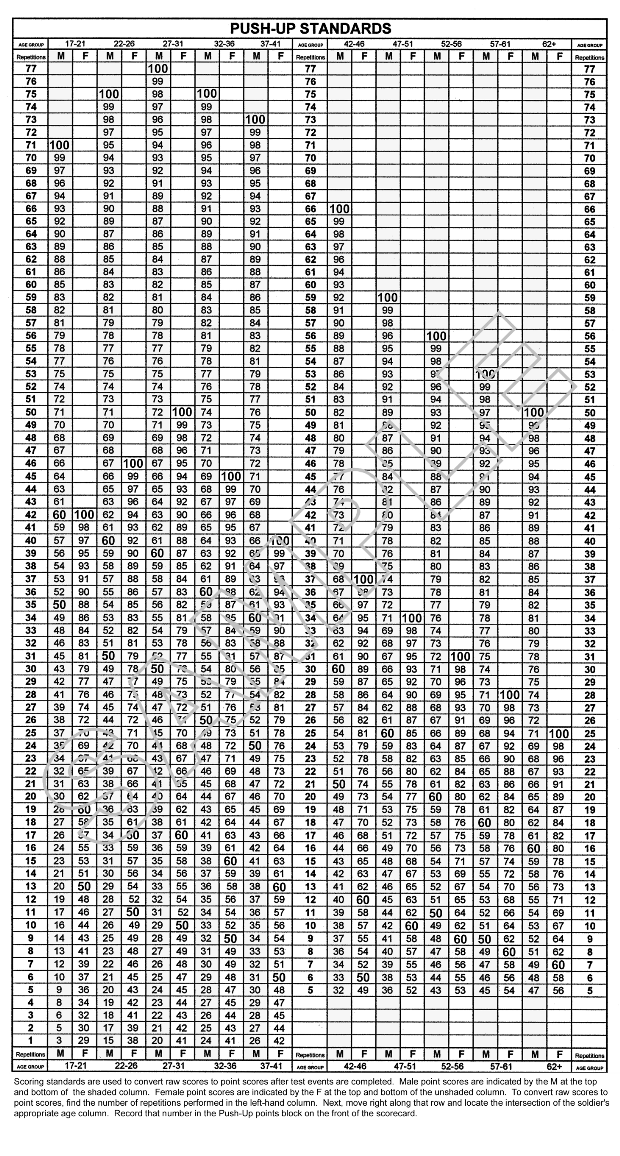The Army PT height and weight chart is an essential guideline that defines the physical fitness standards for service members. These standards are critical for maintaining readiness and ensuring that all personnel meet the health requirements necessary for military duties. In this article, we will explore the importance of the Army PT height and weight chart, the specifics of the standards, and how service members can achieve and maintain these fitness levels.
Physical fitness is a cornerstone of military service, affecting everything from operational effectiveness to individual health. The Army’s Physical Training (PT) program is designed not only to enhance physical capabilities but also to promote overall wellness among soldiers. Understanding the height and weight requirements is key to succeeding in this program and ensuring a soldier's ability to perform their duties effectively.
In the following sections, we will provide a comprehensive overview of the Army PT height and weight chart, including how weight is calculated, the significance of these standards, and tips for meeting them. Whether you are a current service member or considering joining the Army, this guide will equip you with the knowledge you need regarding physical fitness standards.
Table of Contents
- 1. Overview of Army PT Standards
- 2. Height and Weight Requirements
- 3. Age and Gender Considerations
- 4. The Importance of Body Composition
- 5. How to Measure Height and Weight
- 6. Tips for Achieving and Maintaining Standards
- 7. Consequences of Not Meeting Standards
- 8. Conclusion and Call to Action
1. Overview of Army PT Standards
The Army PT standards are designed to ensure that all soldiers are physically capable of performing their duties. These standards encompass a range of physical fitness components, including cardiovascular endurance, muscular strength, flexibility, and body composition.
In addition to the height and weight chart, the Army also conducts a Physical Fitness Test (APFT) that assesses a soldier's performance in several exercises, such as push-ups, sit-ups, and a two-mile run. Together, these evaluations provide a comprehensive picture of a soldier's physical readiness.
2. Height and Weight Requirements
The Army PT height and weight chart establishes the acceptable ranges for soldiers based on their height. The standards vary for males and females, reflecting the physiological differences between genders.
2.1 Height and Weight Chart for Males
| Height (inches) | Minimum Weight (lbs) | Maximum Weight (lbs) |
|---|---|---|
| 60 | 140 | 200 |
| 61 | 144 | 204 |
| 62 | 147 | 209 |
2.2 Height and Weight Chart for Females
| Height (inches) | Minimum Weight (lbs) | Maximum Weight (lbs) |
|---|---|---|
| 60 | 110 | 150 |
| 61 | 114 | 155 |
| 62 | 118 | 160 |
3. Age and Gender Considerations
Age and gender play a crucial role in determining the appropriate height and weight standards. The Army recognizes that physical fitness levels can vary significantly among different age groups and between males and females. Thus, the height and weight requirements are adjusted accordingly to ensure fairness and accuracy in assessing fitness levels.
4. The Importance of Body Composition
Body composition, which refers to the ratio of fat to lean mass in the body, is an essential aspect of overall health and physical fitness. The Army emphasizes that a soldier's ability to perform their duties is not solely based on weight but also on their body composition.
Maintaining a healthy body composition helps reduce the risk of injuries, enhances endurance and strength, and improves overall performance. This is why the Army PT height and weight chart is accompanied by body fat percentage measurements, which provide a more comprehensive view of a soldier's physical health.
5. How to Measure Height and Weight
Accurate measurement of height and weight is vital for determining compliance with Army PT standards. Here are the steps to ensure accurate measurements:
- Stand straight against a wall with heels together and head level.
- Use a flat, rigid ruler to mark the highest point of your head.
- Measure weight using a calibrated scale, ideally in the morning and after using the restroom.
6. Tips for Achieving and Maintaining Standards
Achieving and maintaining the Army PT height and weight standards requires a proactive approach to fitness. Here are some tips:
- Engage in regular cardiovascular exercise, such as running, cycling, or swimming.
- Incorporate strength training exercises to build muscle mass and improve body composition.
- Adopt a balanced diet rich in fruits, vegetables, lean proteins, and whole grains.
- Stay hydrated and get adequate sleep to support recovery and overall health.
7. Consequences of Not Meeting Standards
Failing to meet the Army PT height and weight standards can have serious consequences for soldiers. These may include:
- Increased scrutiny during evaluations and performance reviews.
- Potential administrative actions, including counseling or remediation programs.
- Impact on promotion opportunities and career advancement.
8. Conclusion and Call to Action
Understanding the Army PT height and weight chart is crucial for all service members who aspire to meet the physical fitness standards of the Army. By staying informed about the requirements and actively working to achieve them, soldiers can maintain readiness and enhance their overall health.
We encourage you to leave a comment below sharing your thoughts on the Army PT standards or any personal experiences related to physical fitness in the military. Don’t forget to share this article with fellow service members, and check out our other resources on military fitness!
Thank you for reading, and we look forward to seeing you back on our site for more informative articles!




